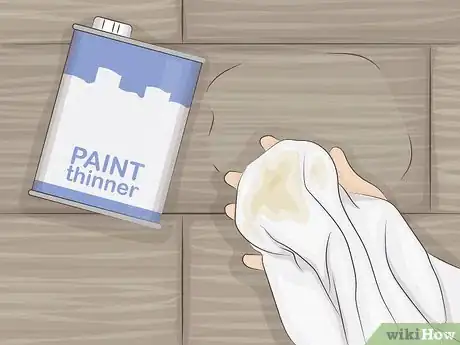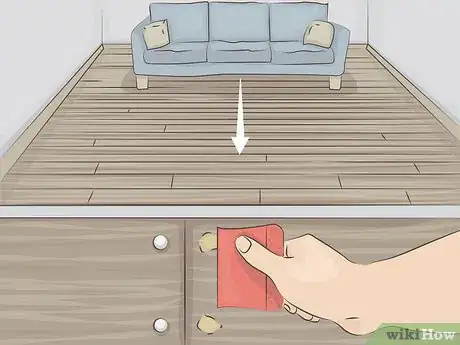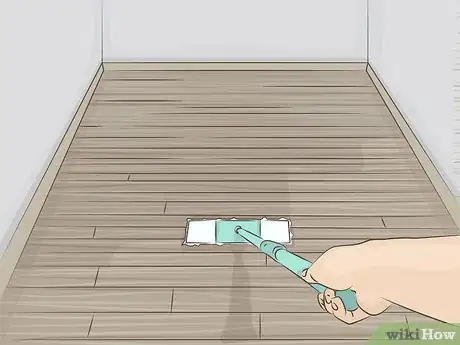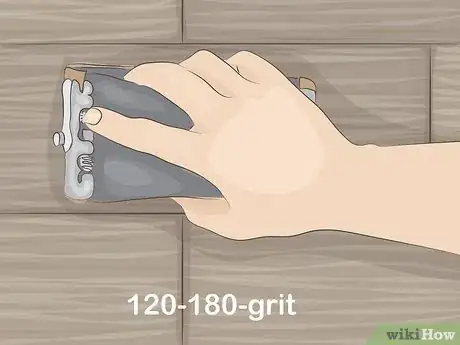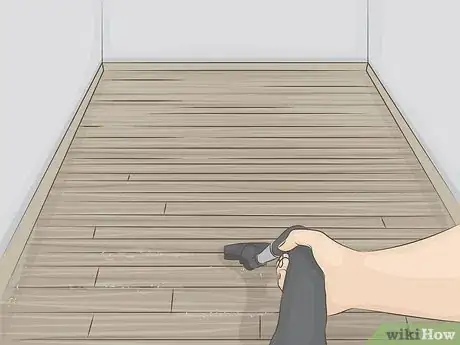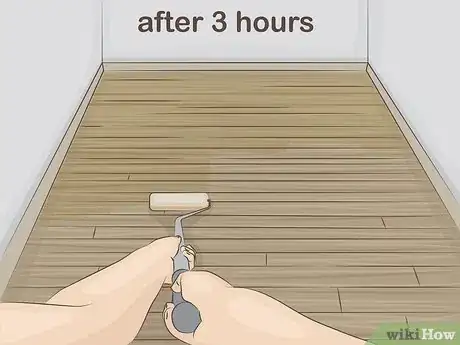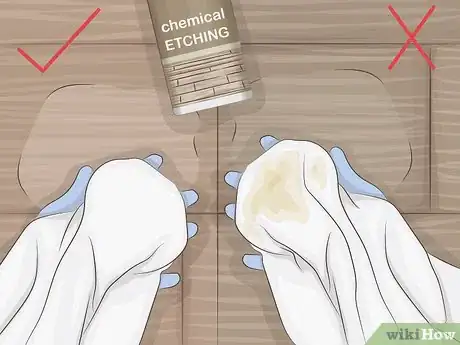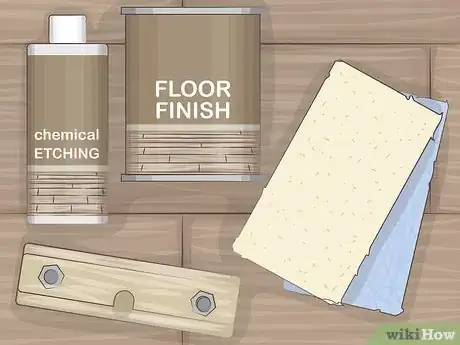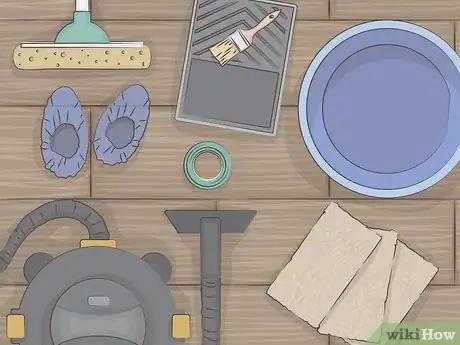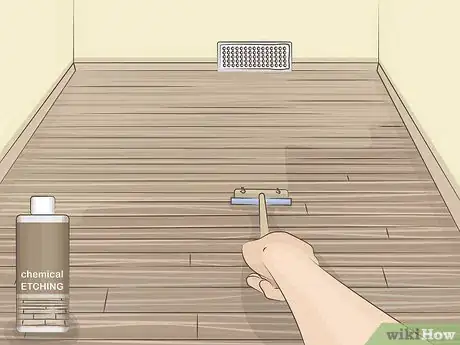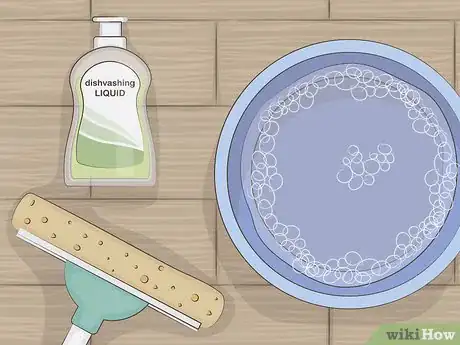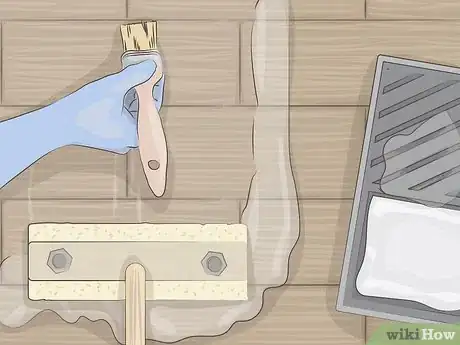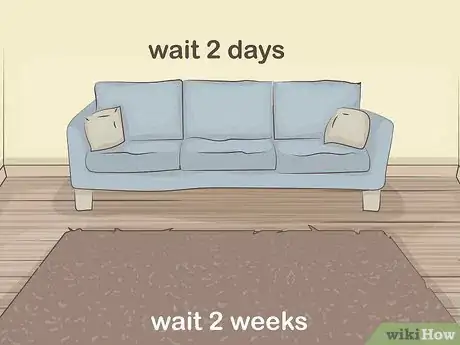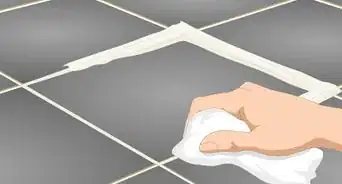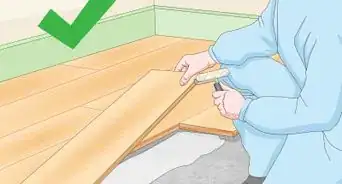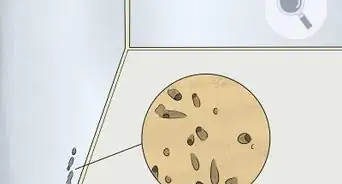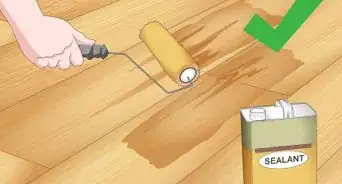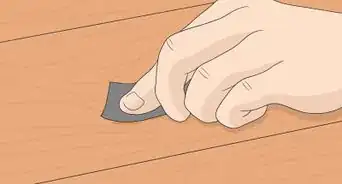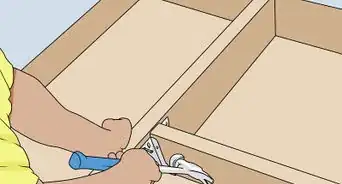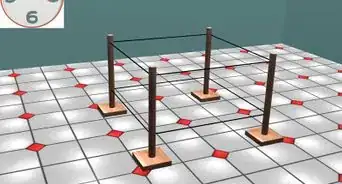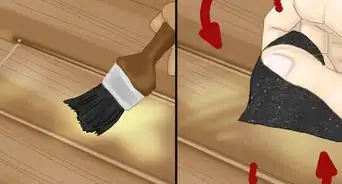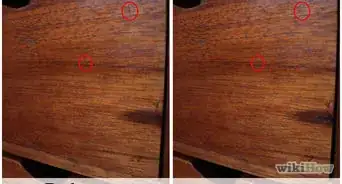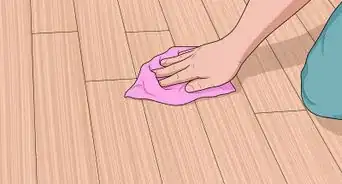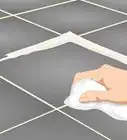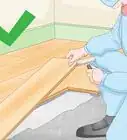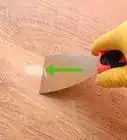This article was co-authored by Crystal Chadwick. Crystal Chadwick is a Licensed General Contractor and the Owner of Yin & Yang Construction out of Salt Lake City, Utah. With over 16 years of experience in the construction industry, she specializes in remodels, repairs, and handyman services. Crystal leads her team with vision and a detail-oriented approach, allowing them to provide quality work and design to their clients.
There are 10 references cited in this article, which can be found at the bottom of the page.
This article has been viewed 42,154 times.
If your hardwood floor is only lightly worn, damaged, or scratched, you may be able to refinish it without sanding. There are two basic methods: buffing or abrading the existing coat before refinishing, or, alternatively, applying a chemical “etching” kit. Either way, you’ll be able to refinish your hardwood floors relatively quickly and without the hassle, expense, and equipment required to sand to bare wood.
Steps
Buffing and Recoating
-
1Check your floor to make sure it doesn’t have a wax finish. If your floor has been finished with wax, rather than oil or lacquer, buffing and recoating won’t work because the finish may end up leaving ugly bubbles.
- Apply paint thinner or mineral spirits to a small, inconspicuous spot that’s been cleaned.
- Wipe a white rag over the spot; if it turns brown or yellow, the finish may be wax.[1]
- If your floor does have a wax finish, you may be able rewax and polish the floors using a buffing machine with a steel wool pad.[2]
-
2Clear the room completely and make any necessary repairs to the floor. If any floorboard nails are protruding, you should pound them in to just below the surface with a hammer and point. Fill the resulting hole with wood putty, allow a few hours for it to dry, then sand it lightly with the grain until it’s flush with the floor.[3]Advertisement
-
3Clean the floor thoroughly and allow it to dry. Sweep, vacuum, and mop with a commercial hardwood floor cleaner that will clean away any contaminants without dissolving the existing finish. Let your floor dry.[4]
-
4Abrade the floor lightly, by hand or with a buffing machine. This is the part of refinishing-the-floor-without-sanding that requires sanding...but just a little. You won’t be sanding the floor to bare wood as you would for a full refinishing. You’ll just be lightly abrading or scuffing the surface to remove imperfections in the existing finish and prepare it so that the new coat bonds well.[5]
- You can rent buffing machines at a hardware store or home center, but the job can also be done by hand, if you prefer.
- Use 120-180-grit sandpaper to lightly buff or sand the floor. You don’t need to be too thorough or apply too much pressure; just work the finish until a powder forms.
- Prepare the perimeter sanding by hand, then use the buffer, moving from side-to-side along the grain of the floor.[6]
-
5
-
6Apply the oil or lacquer finish. Cover your shoes with booties and your nose and mouth with a respirator to avoid breathing in noxious vapors. You’ll use a brush along the edges and a long-handled roller for the center of the floor.[9]
- Be sure you know whether your floor has an oil- or lacquer-based finish. If your floor was previously lacquered and you apply an oil finish, for example, the incompatibility of the finishes may lead to problems like delamination or discoloration.[10]
- Oiled floors tend to wear faster in heavily-trafficked ares and are more easily stained than lacquered floors. They also tend to be darker, duller, and more “orangey” that lacquered floors.[11]
-
7Wait at least three hours before applying a second coat. But be sure to follow the manufacturer’s instructions on drying time. The finish may dry quickly for walking with stocking feet, but wait a few days or a week before moving furniture back, and be sure not to slide it across the floor when you do.[12]
Using a Store-Bought Kit
-
1Determine if using a “chemical etching” kit is the best method. Use this method if your hardwood floor is worn and scratched but not so damaged that it needs sanding before refinishing. Instead of buffing the floor to prepare it for a new finish, with this method you’ll apply a chemical solution to do that job.[13]
- This method won’t work with wax-finished floors.
- If you don’t know if you have a wax-finished floor, you may check it by applying paint thinner or mineral spirits to a small, inconspicuous spot that’s been cleaned. Wipe a white rag over the spot; if it turns brown or yellow, the finish may be wax.[14]
-
2Buy a refinishing kit. Refinishing kits may cost around $100USD, and are available at large home centers and hardware stores. You may shop around online to find the one that’s right for you. You may decide to use the buffing method instead if chemical etching looks to be too expensive or troublesome.
-
3Gather the tools and materials required by your kit. You’ll need a bucket, paint tray, paint brush, sponge mop, shoe covers, a shop vacuum, abrasive pads, painter’s tape, and whatever other materials the kit requires.[15]
-
4Clear the room and thoroughly clean the floor. You’ll also want to make the room as dust-free as possible by turning off the HVAC prior to coating, because any dust in the air may land on the wet finish and create “whiskers” on the floor. You may also need to close the curtains because direct sunlight may cause the finish to dry too quickly in spots.[16]
-
5Apply the liquid etcher to roughen the floor surface for the finish. Follow the manufacturer’s instructions for applying the etcher. You’ll have to scrub it firmly into the grain with the abrasive pad supplied in the kit, which may be attached to a mop handle. Let the floor dry for about 30 minutes.[17]
-
6Mop the floor. Use a solution of 2 tablespoons (30 mL) of dishwashing liquid in 1 gallon (3.8 L) of warm water. This will remove any remaining residue and help to neutralize the chemical etcher.[18]
-
7Touch up any scratches in the wood when the floor drys. Use an artist’s brush to apply a matching stain to the scratch, blotting out the excess with a rag. Dry it with a hair dryer for about a minute, and then seal it with the finish provided in the kit.[19]
-
8Apply the finish using the kit’s applicator pad. Application specifications will vary depending on the kit, so follow the manufacturer’s specific instructions precisely. You may need an assistant to help with application, because the finish may become gummy if left to stand for more than 10 minutes. Your helper can smooth out any drips or bubbles.[20]
- Most kits will contain enough for two coats on over 225 square feet (20.9 m2).
- A second coat may be a good idea to further hide any scratches.
-
9Allow time to dry. The finish should be ready for stocking feet after about 8 hours and furniture after a day or two. You may want to wait 2 weeks before putting down a rug, though.[21]
Expert Q&A
-
QuestionAre rug pads bad for hardwood floors?
 Sam AdamsSam Adams is the owner of Cherry Design + Build, a residential design and construction firm, which has been operating in the Greater Seattle Area for over 13 years. A former architect, Sam is now a full-service contractor, specializing in residential remodels and additions.
Sam AdamsSam Adams is the owner of Cherry Design + Build, a residential design and construction firm, which has been operating in the Greater Seattle Area for over 13 years. A former architect, Sam is now a full-service contractor, specializing in residential remodels and additions.
Professional Contractor The pads themselves aren't bad. That said, dust and dirt can get underneath it. After this, the rug that should've been protecting the floor may act like a piece of sandpaper, damaging the hardwood.
The pads themselves aren't bad. That said, dust and dirt can get underneath it. After this, the rug that should've been protecting the floor may act like a piece of sandpaper, damaging the hardwood.
References
- ↑ https://www.nytimes.com/2016/10/16/realestate/making-your-wood-floors-look-like-new.html
- ↑ https://www.profloortips.com/hardwood/hardwood-floor-refinishing/
- ↑ https://www.oldhouseonline.com/articles/7-steps-to-like-new-floors
- ↑ http://refinishingfurniture.net/refinishing-hardwood-floors-without-sanding/
- ↑ http://howtosandafloor.com/how-to-refinish-a-wood-floor-without-sanding/
- ↑ https://www.thisoldhouse.com/how-to/how-to-refinish-wood-floors
- ↑ Crystal Chadwick. Licensed General Contractor. Expert Interview. 16 March 2021.
- ↑ Crystal Chadwick. Licensed General Contractor. Expert Interview. 16 March 2021.
- ↑ https://www.youtube.com/watch?v=mP1GPm9c5Bs
- ↑ https://www.youtube.com/watch?v=mP1GPm9c5Bs
- ↑ http://howtosandafloor.com/how-to-refinish-a-wood-floor-without-sanding/
- ↑ https://www.oldhouseonline.com/articles/7-steps-to-like-new-floors
- ↑ https://www.familyhandyman.com/floor/hardwood-floors/refinish-hardwood-floors-in-one-day/view-all/
- ↑ https://www.nytimes.com/2016/10/16/realestate/making-your-wood-floors-look-like-new.html
- ↑ https://www.familyhandyman.com/floor/hardwood-floors/refinish-hardwood-floors-in-one-day/view-all/
- ↑ http://refinishingfurniture.net/refinishing-hardwood-floors-without-sanding/
- ↑ https://www.familyhandyman.com/floor/hardwood-floors/refinish-hardwood-floors-in-one-day/view-all/
- ↑ https://www.familyhandyman.com/floor/hardwood-floors/refinish-hardwood-floors-in-one-day/view-all/
- ↑ https://www.familyhandyman.com/floor/hardwood-floors/refinish-hardwood-floors-in-one-day/view-all/
- ↑ https://www.familyhandyman.com/floor/hardwood-floors/refinish-hardwood-floors-in-one-day/view-all/
- ↑ https://www.familyhandyman.com/floor/hardwood-floors/refinish-hardwood-floors-in-one-day/view-all/
